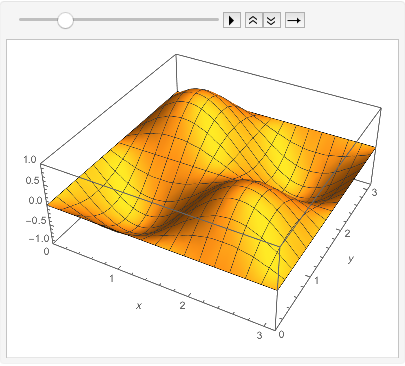I didn't have much luck with DSolve, but I did with NDSolve. Please have a look at the boundary and initial conditions. You should have 2 boundary conditions for x, 2 boundary conditions for y, and 2 initial condition equations for t. I made some up. These could be other things.
Clear[L, c, weq2, bc2, ic2, sol2, u, x, y, t, m, n]
weq2 = Laplacian[u[x, y, t], {x, y}] == D[u[x, y, t], {t, 2}]
bc2 = {u[x, Pi, t] == 0, u[x, 0, t] == 0, u[0, y, t] == 0,
u[Pi, y, t] == 0}
ic2 = {u[x, y, 0] == Sin[m x] Sin[n y],
Derivative[0, 0, 1][u][x, y, 0] == 0}
sol2 = DSolve[{weq2, bc2, ic2}, u[x, y, t], {x, y, t},
Assumptions -> {Element[m | n , Integers]} ]
DSolve failed to find a solution. I had no trouble doing the same for 1D, but 2D it just isn't happy. Maybe someone can figure that out. So on with NDSolve
nsol2 = NDSolve[{weq2, bc2, ic2} /. {m -> 2, n -> 2},
u, {x, 0, Pi}, {y, 0, Pi}, {t, 0, 5}]
ListAnimate[
Table[Plot3D[u[x, y, t] /. nsol2, {x, 0, \[Pi]}, {y, 0, \[Pi]},
AxesLabel -> Automatic,
PlotRange -> {{0, \[Pi]}, {0, \[Pi]}, {-1, 1}}], {t, 0, 5}]]
You should get an animation with time ....
